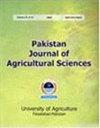Assessment of cotton germplasm against CLCuD at different locations and determination of inheritance patterns for resistance
IF 0.6
4区 农林科学
Q3 AGRICULTURE, MULTIDISCIPLINARY
引用次数: 0
Abstract
Leaf curl virus disease of cotton is major hindrance in cotton production in Pakistan for last many years. To counter leaf curl disease an experiment was designed to screen out new local and exotic germplasm from different institutes of the country and neighboring countries like Turkey and India to find out the tolerance level of 71 cotton genotypes. The genotypes were sown in the month of June using randomized complete block design and sick plot technique at two locations i.e., Faisalabad and Vehari (hot spots). The variety FH-118 was used as spreader line in this experiment. The lines naming FH-490, FH-444, FH458, VH-363 and varieties like FH-142, NIAB-878, FH-Lalazar, VH-327 provided very good results at both locations under virus infested conditions with better yield and low infection of virus. The screening criterion was based on virus tolerance and performance of genotypes with respect to superior boll numbers, sympodial branches and boll weight along with plant height and fibre quality. For the assessment of inheritance pattern of CLCuD resistance, nine selected parents including 6 females and 3 male testers were crossed using a line × tester mating system followed by line × tester analysis to further evaluate the combining ability of different crosses. The ability of parents to combine well for CLCuD % revealed that FH-490 (-9.69) followed by FH-444 (-9.23) showed negative and highly significant estimates among lines while among testers, FH-142 (- 9.66) remained highly significant and negative. Specifically, the negative and highly desirable estimates were provided by the cross combination namely FH-490 × VH-327 (-8.95), FH-458 × FH-142 (-7.81), VH-363 × FH-Lalazar (-6.90), MNH1016 × VH-327 (-5.09), FH-490 × FH-142 (-4.17). Dominance variance was higher than additive variance for most of the characters studied including CLCuD tolerance. The results concluded that the identified parents and crosses obtained can further be manipulated for future breeding aimed at CLCuD tolerance in Pakistan and all over the world.棉花不同部位抗CLCuD种质资源的鉴定及抗性遗传模式的确定
棉花卷叶病毒病是巴基斯坦棉花生产多年来的主要障碍。为了对抗弯叶病,设计了一项实验,从该国不同研究所以及土耳其和印度等邻国筛选出新的本地和外来种质,以了解71种棉花基因型的耐受水平。基因型于6月份在费萨拉巴德和韦哈里(热点)两个地点使用随机完全区组设计和病区技术播种。本试验以FH-118为试验材料。命名为FH-490、FH-444、FH458、VH-363的品系和FH-142、NIAB-878、FH-Lalazar、VH-327的品种在病毒感染条件下在这两个位置都提供了非常好的结果,具有更好的产量和低的病毒感染率。筛选标准基于病毒耐受性和基因型在优势铃数、同轴分枝和铃重以及株高和纤维质量方面的表现。为了评估CLCuD抗性的遗传模式,选择了9个亲本,包括6个雌性和3个雄性试验者,采用品系×试验者交配系统进行杂交,然后进行品系×测试者分析,以进一步评估不同组合的配合力。父母对CLCuD%的良好结合能力表明,FH-490(-9.69)和FH-444(-9.23)在品系中显示出阴性和高度显著的估计,而在测试者中,FH-142(-9.66)仍然保持高度显著和阴性。具体而言,FH-490×VH-327(-8.95)、FH-458×FH-142(-7.81)、VH-363×FH-Lalazar(-6.90)、MNH1016×VH-32(-5.09)、FH-490 x FH-142。研究结果表明,所鉴定的亲本和获得的杂交种可以进一步操作,用于未来在巴基斯坦和世界各地进行CLCuD耐受性育种。
本文章由计算机程序翻译,如有差异,请以英文原文为准。
求助全文
约1分钟内获得全文
求助全文
来源期刊

Pakistan Journal of Agricultural Sciences
AGRICULTURE, MULTIDISCIPLINARY-
CiteScore
1.80
自引率
25.00%
发文量
18
审稿时长
6-12 weeks
期刊介绍:
Pakistan Journal of Agricultural Sciences is published in English four times a year. The journal publishes original articles on all aspects of agriculture and allied fields.
 求助内容:
求助内容: 应助结果提醒方式:
应助结果提醒方式:


